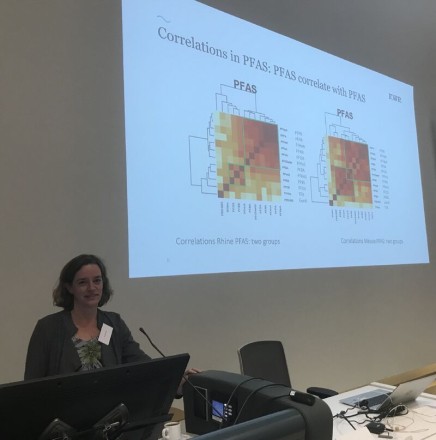Summary of symposium
Around 60 people gathered in Amsterdam to listen to and interact with the invited speakers discussing their latest findings on PFAS hazards, occurrence, exposure, and risks in the aquatic and terrestrial environment. The first speaker, Sanne Brekelmans discussed PFAS occurrence in Dutch surface waters and highlighted the potentially conflicting issue of TFA, should that compound be included in the legislation for drinking water. Next, Tessa Pronk uncovered the information on PFAS dynamics hidden in monitoring data for the rivers Meuse and Rhine. She showed how PFAS loads can be predicted, and how emissions events may be identified.

Ioanna Gkika took a deep dive into PFAS accumulation dynamics in submerged water plants (macrophytes) under the presence of invertebrates. She illustrated how sediment-associated PFAS are taken up by macrophytes and how bioturbation by sediment-dwelling organisms can affect that uptake. Interestingly, PFAS uptake by plants was substantial and increased due to the presence of worms. Cara Byns reported on PFAS accumulation patterns in North Sea fish and highlighted the regulatory challenges related to the use of biota quality standards for PFAS. She demonstrated that zebra mussels can be used as biomonitors for PFAS and that concentrations of several long-chain PFAS could be related to a macroinvertebrate quality standard.
Taking a turn to hazard assessment, Jaimy de Schepper evaluated a bioassay that is used for the detection of thyroid effects induced by PFAS. He illustrated that in some cases, 29 PFAS only explain up to 5% of the observed effects, suggesting that other PFAS (and other chemicals) yet unknown to us dominate the bioassay responses. Next, Ayesha Siddiqa highlighted the lack of chronic toxicity data for PFAS, even though their persistence leads to long-term environmental exposures. She investigated responses to chronic PFOS exposure in insects and crustaceans and showed that insects appear to be especially sensitive. Diving even deeper into the long-term effects of PFAS, Skylar Xie investigated the multigeneration toxicity of PFAS to aquatic and terrestrial invertebrates. This showed that Daphnia magna became increasingly sensitive to PFAS over generations and illustrated that multigeneration effects are important in the environmental risk assessment of PFAS.
Thimo Groffen investigated PFAS profiles in Chinese mitten crabs from Belgian waters and sediments and concluded that this crab fulfills many of the requirements of biomonitors but is not the best bioindicator for local pollution. However, they may be used to provide complementary information to fish biomonitors. Finally, Stefan van Leeuwen took the food safety perspective of PFAS and showed that our food may get contaminated by the local environment, as shown for fish, fruits, and vegetables. Nonetheless, he also highlighted that governance can help regulate PFAS exposure through food and protect populations.
Besides the oral presentations, several exciting posters were presented and stimulated fruitful discussions, and a platform discussion fired with provoking statements wrapped up a great day. This meeting highlighted how PFAS keeps gaining attention in scientific research as well as the media. Next to the progress of PFAS research at universities and research laboratories, it was a great opportunity for environmental toxicologists and chemists from several research groups in the Netherlands and Flanders to meet and exchange knowledge. We look forward to another meeting organized by MCT, to stimulate scientific progress and interaction on PFAS and beyond!
The full programme is available here: https://mct.kncv.nl/pfas-2023-programme

